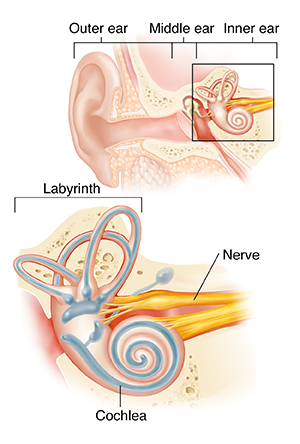When Your Child Has Vertigo
Your child is standing still, but they feel like they're moving or spinning. This feeling is called vertigo. Vertigo can be uncomfortable. But it’s often not a sign of a major health problem. Vertigo can be treated so your child feels better.
Understanding the balance system
The inner ear plays a key role in helping the body keep its balance. To do this, the inner ear senses head and body position, and motion. It also works with other parts of the body, such as the eyes. The body relies on the inner ear for balance signals. Signals sent to the brain from the inner ear, eyes, and other areas help the body stay balanced.

What causes vertigo?
The exact cause of vertigo is not always known. But if your child has an inner ear problem, the brain may be getting the wrong signals. This can lead to vertigo. Here are the most common causes of inner ear problems in children:
-
Things that cause congestion (such as colds, allergies, or sinus infection). This leads to fluid backup through the Eustachian tube, which links the ear to the sinuses.
-
Labyrinthitis. This condition is caused by a viral infection of the labyrinth (a part of the inner ear).
-
Closed head injury. Sometimes children can damage their inner ear structures when getting a head injury, causing vertigo. Sometimes the inner ear will stay intact, but children will have a concussion after a head injury. That can cause symptoms like dizziness or vertigo.
-
Meniere's disease. This is when the body makes an abnormal amount of fluid in the inner ear. It leads to episodes of vertigo linked with ringing in the ears and hearing loss. It is uncommon. But it can occur in children.
-
Benign paroxysmal vertigo of childhood. Symptoms include the sudden sensation of spinning, loss of balance, nausea, and vomiting. These episodes may occur several times a month for several years. They often go away by age 8.
-
Basilar artery migraine. This type of migraine can cause both headache and vertigo. The symptoms of vertigo often go away when the headache does.
How is vertigo diagnosed?
The healthcare provider will ask about your child’s overall health and symptoms. This is the main way that vertigo is diagnosed. Your child will also be examined, especially their head and ears. There isn’t a specific test to diagnose vertigo. In some cases, tests like an MRI or CT scan of the brain may be done to rule out other health problems.
How is vertigo treated?
Often, vertigo will go away on its own without treatment. If vertigo is caused by an inner ear problem, the healthcare provider may prescribe medicine. They can help your child’s balance system get back to normal. The most common medicines are:
-
Antihistamines to treat inner ear problems
-
Motion sickness medicine (if needed)
-
Antibiotics, antivirals, or steroids if it may be an ear infection
Keep your child from activities that require balance or coordination until vertigo is gone. This includes:
- Gymnastics
- Dancing
- Skateboarding
- Riding a bike or scooter
- Rollerskating
- Driving
When to call your child's healthcare provider
Call your child’s healthcare provider right away if you notice any of these:
-
Repeated or longer than usual episodes of vertigo
-
Severe vertigo (child can't move)
-
Vertigo along with another problem, such as ear ringing, ear pain, headache, ear stuffiness, or hearing loss
-
Confusion or change in behavior
- New or abnormal symptoms that concern you